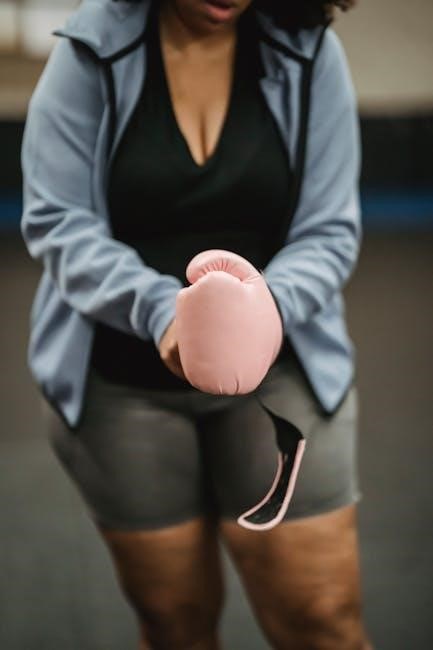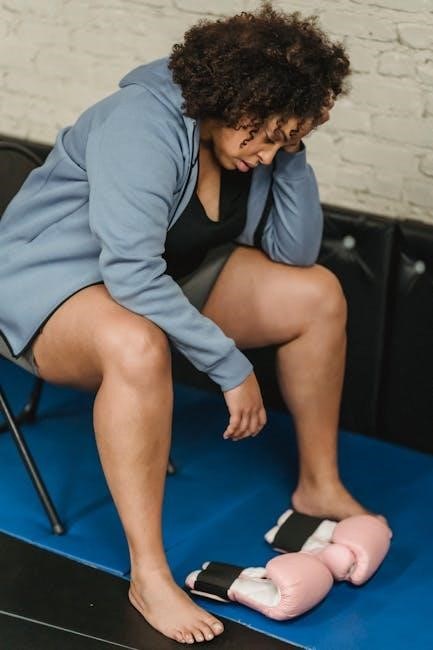Glove sizing ensures a perfect fit for optimal functionality and comfort. Measure hand circumference and length to determine size. Use charts for accurate sizing. Proper fit enhances dexterity and avoids tightness. Different brands and activities may require specific sizing. Understanding glove sizing guides helps choose the right pair for any purpose.
Importance of Proper Fit
A proper fit is crucial for both functionality and comfort when it comes to gloves. Whether for work, sports, or everyday use, ill-fitting gloves can hinder performance and cause discomfort. A glove that is too tight may restrict movement and circulation, while one that is too loose can reduce dexterity and grip. Properly fitted gloves ensure optimal tactile sensitivity, allowing for precise actions in tasks that require fine motor skills.
For athletes, especially in sports like baseball or hockey, a well-fitting glove is essential for control and safety. It provides the necessary support and protection without compromising agility. In work environments, such as construction or manufacturing, gloves that fit correctly are vital for safety, preventing accidents caused by poor grip or restricted movement.

Additionally, proper fit extends the lifespan of gloves. Gloves that are too tight may stretch or tear prematurely, while those that are too loose may wear out unevenly. Investing time in measuring and selecting the right size ensures long-term comfort and durability. Ultimately, a glove that fits perfectly enhances productivity, safety, and overall satisfaction, making it a worthwhile effort to prioritize proper sizing.

How to Measure Your Hand
To measure your hand for glove sizing, wrap a measuring tape around the widest part of your dominant hand, excluding the thumb. Measure from the tip of your middle finger to the base of your hand for length. Use a string or flexible tool if a tape measure is unavailable, then measure the string with a ruler.
3.1 Using a Measuring Tape

Measuring your hand with a tape measure is the most accurate way to determine your glove size. Start by wrapping the tape around the widest part of your dominant hand, typically just below the knuckles and excluding the thumb. Hold the tape snug but not too tight to ensure a natural fit. Take note of the circumference in inches, as this will serve as your primary measurement.
Next, measure the length of your hand from the tip of your middle finger to the base of your palm. This measurement helps ensure the gloves will fit comfortably from fingertip to wrist. For the best results, use your dominant hand, as it is usually slightly larger than the non-dominant hand.
Once you have both measurements, refer to a glove size chart to find your corresponding size. Some charts may list sizes numerically, while others use standard labels like Small, Medium, or Large. If your measurements fall between sizes, consider the activity or material of the gloves, as some may require a tighter or looser fit for optimal performance.
Remember, proper sizing ensures maximum dexterity and comfort, making it essential to take your time and measure accurately. If you’re unsure, consult the specific sizing guide provided by the manufacturer or retailer, as variations may exist between brands.
3.2 Measuring Without a Tape Measure
If you don’t have a measuring tape, you can still determine your glove size using simple household items. One effective method is to use a string, a ruler, and a pencil. Wrap the string around the widest part of your dominant hand, just below the knuckles and excluding the thumb, to replicate how a tape measure would fit. Mark the point where the string overlaps with a pencil.
Next, lay the string flat on a surface and measure the length between the marked points using a ruler. This measurement will give you the circumference of your hand. Compare this to a glove size chart to find your size. Alternatively, you can use a flexible object like a strip of paper or dental floss to wrap around your hand and measure its length with a ruler.
For added accuracy, repeat the process a few times to ensure consistency. If you’re still unsure, consider printing a glove size chart from a reliable source and tracing your hand to estimate the fit. These methods provide a practical solution for measuring your hand without specialized tools, ensuring you can find the right glove size for comfort and functionality.

- Use a string or flexible material to wrap around your hand.
- Measure the length of the wrapped material with a ruler.
- Compare the measurement to a glove size chart.
These steps ensure accuracy and convenience for determining your glove size without a tape measure.

Understanding Glove Size Charts
Glove size charts help determine the perfect fit by comparing hand measurements to standard sizes. They typically include measurements for hand circumference and length. By matching your measurements to the chart, you can select gloves that offer comfort and functionality. Different brands may vary, so always refer to the specific chart provided.
4.1 Standard Size Charts
Standard glove size charts provide a universal guide to help individuals determine their glove size based on hand measurements. These charts typically include measurements for hand circumference and hand length, allowing users to find a size that ensures comfort and functionality. To use a standard size chart, measure your hand circumference by wrapping a tape measure around the widest part of your hand, just below the knuckles, excluding the thumb. Next, measure the length of your hand from the tip of your middle finger to the base of your palm. Compare these measurements to the chart to find your corresponding glove size.
Most standard size charts categorize gloves into sizes such as small, medium, large, and extra-large, though some may use numerical sizing. For accuracy, measure your dominant hand, as it tends to be slightly larger than the non-dominant hand. If you don’t have a tape measure, you can use a string or flexible object to wrap around your hand and then measure its length with a ruler. This method ensures you can still determine your size without specialized tools.
Printable size charts are often available online, making it easier to measure and compare your hand size accurately. Always refer to the specific chart provided by the manufacturer, as sizing can vary slightly between brands. By following these steps, you can confidently select gloves that fit perfectly, ensuring optimal performance and comfort for your intended activity.
4.2 Sizing by Activity Type
Glove sizing varies depending on the activity or use case, as different tasks require specific fits for optimal performance. For example, sports gloves, such as those used in hockey or baseball, often have sizing charts tailored to ensure a snug yet flexible fit, allowing for precise control and movement. Work gloves, on the other hand, may prioritize durability and protection, with sizing that accommodates thicker materials while maintaining dexterity.
Winter gloves typically have a looser fit to allow for layering and insulation, while cycling gloves may require a tighter fit to prevent slipping on the handlebars. Understanding the specific demands of your activity helps in selecting the right size. For instance, skiing gloves need to fit securely to maintain grip on poles, whereas gardening gloves might allow for a bit more room for comfort during extended use.
Manufacturers often provide activity-specific sizing charts, so it’s important to refer to these guides when choosing gloves. Additionally, some gloves are designed with adjustable features, such as Velcro straps or elastic cuffs, to customize the fit further. By considering the unique requirements of your activity, you can ensure your gloves provide the necessary support, protection, and comfort for your needs.
Always check the sizing chart provided by the manufacturer, as activity-specific gloves may differ from standard sizing. This ensures the best fit and performance for your intended use.

Factors Affecting Glove Fit
Hand shape, size, and activity type significantly impact glove fit. Materials and thickness also play a role, as they affect comfort and dexterity. Proper sizing ensures optimal performance, whether for sports, work, or winter activities, by balancing protection, flexibility, and comfort.
5.1 Hand Shape and Size
Hand shape and size are critical factors in determining the perfect glove fit. Every individual’s hand is unique, with variations in palm width, finger length, and overall circumference. To ensure optimal comfort and functionality, gloves must accommodate these differences. Measuring the hand accurately is essential, focusing on the dominant hand, as it tends to be slightly larger. The circumference, measured around the widest part of the hand excluding the thumb, provides a baseline for sizing. Additionally, the length from the base of the hand to the tip of the middle finger is often considered to ensure proper fit.
Hand shape can vary significantly, ranging from slender to broad palms, and even finger proportions differ. For instance, some individuals may have longer fingers but a narrower palm, while others may have shorter fingers with a wider palm. These variations can affect how a glove fits, making it essential to choose a size that balances both dimensions. Proper sizing ensures that the glove is neither too tight nor too loose, allowing for full dexterity and comfort. Whether for sports, work, or casual use, understanding hand shape and size is the foundation for selecting the right glove.
Using a measuring tape or alternative tools like a string and ruler can help determine accurate measurements. Comparing these measurements to a glove size chart ensures the best fit. Hand shape and size are fundamental factors that should never be overlooked when choosing gloves for any purpose.

5.2 Activity and Use Case
The intended activity or use case significantly influences glove sizing and fit. Different activities require varying levels of dexterity, protection, and grip, which can affect how a glove should fit. For example, sports gloves, such as those used in baseball or hockey, prioritize a snug fit to ensure precise control and responsiveness. In contrast, work gloves may emphasize durability and protection, potentially allowing for a slightly looser fit to accommodate padding or reinforced materials.
Winter gloves, designed for cold weather, often need to balance warmth with dexterity. A tighter fit ensures minimal heat loss, while a slightly roomier design may accommodate layers like liners. Similarly, gloves for specific tasks, such as gardening or mechanics, may require a fit that allows for flexibility and ease of movement while protecting the hands from abrasions or chemicals.
Understanding the specific demands of the activity helps in selecting the right glove size. For instance, a glove that is too tight for a high-dexterity task may restrict movement, while one that is too loose could compromise grip or precision. Consulting activity-specific size charts or guides can provide a more accurate fit tailored to the intended use. Ultimately, matching the glove size to the activity ensures both comfort and performance.

5.3 Material and Thickness
Material and thickness play a crucial role in determining glove fit and comfort. Thicker materials, such as leather or heavy-duty synthetics, may require a slightly larger size to accommodate the added bulk, ensuring the glove remains comfortable and flexible. Thinner materials, like lightweight synthetics or cotton, can fit more snugly without needing to size up.
Different materials also have varying degrees of stretch and breathability, which can affect how they conform to the hand. For example, gloves made from elastic or spandex blends may provide a tighter fit, while gloves with padding or insulation, such as winter gloves, may need a looser fit to allow for layering or movement. The thickness of the material can also influence dexterity; thicker gloves may reduce sensitivity, while thinner ones prioritize touch precision.
When selecting a glove size, consider both the material’s thickness and its intended use. For instance, work gloves with reinforced palms may require a slightly larger size to ensure comfort during prolonged use, while sports gloves might prioritize a snug fit for better control. Ultimately, the combination of material and thickness should balance protection, dexterity, and comfort to meet the specific demands of the activity or task at hand.

Converting Measurements to Glove Sizes
Converting hand measurements to glove sizes involves using a size chart to match your hand circumference and length to the corresponding glove size. Most gloves are sized based on the circumference of the hand, measured around the widest part below the knuckles, excluding the thumb. This measurement is typically converted into a numeric or alpha size (e.g., small, medium, large).
To convert your measurement, wrap a flexible tape measure or string around your dominant hand at the widest point. Record the measurement in inches or centimeters and compare it to a standard glove size chart. For example, a hand circumference of 7-7.5 inches usually corresponds to a medium size, while 8-8.5 inches aligns with a large. Some charts may also include hand length, measured from the tip of the middle finger to the base of the hand.
Keep in mind that sizing can vary slightly between brands and activities. For instance, winter gloves may require a looser fit to accommodate thickness, while sports gloves might fit more snugly for better dexterity. If unsure, consider sizing up for bulkier materials or down for a tighter fit. Always refer to the specific brand’s size chart for the most accurate conversion.
By accurately converting your measurements, you can ensure a glove that balances comfort, functionality, and performance for your intended use.
How to Choose the Right Glove Size
Choosing the right glove size ensures comfort, functionality, and optimal performance. Start by measuring your hand circumference and length, then refer to a glove size chart to find your size. Measure around the widest part of your hand below the knuckles, excluding the thumb, using a flexible tape or string. Record the measurement in inches or centimeters and compare it to the chart.
Consider the material and thickness of the gloves, as bulkier materials may require a slightly larger size for comfort. If the gloves are for sports or activities requiring dexterity, opt for a snug fit. For winter gloves, you may prefer a looser fit to accommodate layers. Always check the specific brand’s size chart, as sizing can vary.
If possible, try gloves on before purchasing to ensure a proper fit. Pay attention to how the gloves feel—avoid tightness that restricts movement or looseness that compromises grip. Ensure the fingertips align with the glove’s tips for precise control. Properly fitted gloves enhance performance, safety, and comfort, making them essential for any activity.
By combining accurate measurements, understanding material needs, and considering activity requirements, you can confidently select the right glove size for your needs.
Tips for Specific Glove Types
Different activities and purposes require tailored glove fits. For winter gloves, prioritize a roomy fit to accommodate layers, but avoid excessive looseness that reduces dexterity. Sports gloves, such as hockey or baseball gloves, should fit snugly to ensure precise control and responsiveness. Work gloves need to balance protection with flexibility, so choose a size that allows full hand movement while maintaining durability.
When selecting gloves for specific tasks, consider the material thickness and its impact on fit. Thicker materials may require a slightly larger size for comfort. For example, mechanic gloves should fit tightly enough to prevent tools from slipping, but not so tight that they restrict circulation. Similarly, cycling gloves should provide a secure fit around the palm and fingers for grip stability.
For gloves with padding or reinforced areas, ensure the padding aligns correctly with your hand. If the gloves have adjustable closures, use them to fine-tune the fit. Always refer to the manufacturer’s size chart, as sizing can vary between brands and styles. By matching the glove type to your specific needs, you can achieve the perfect balance of comfort and functionality.